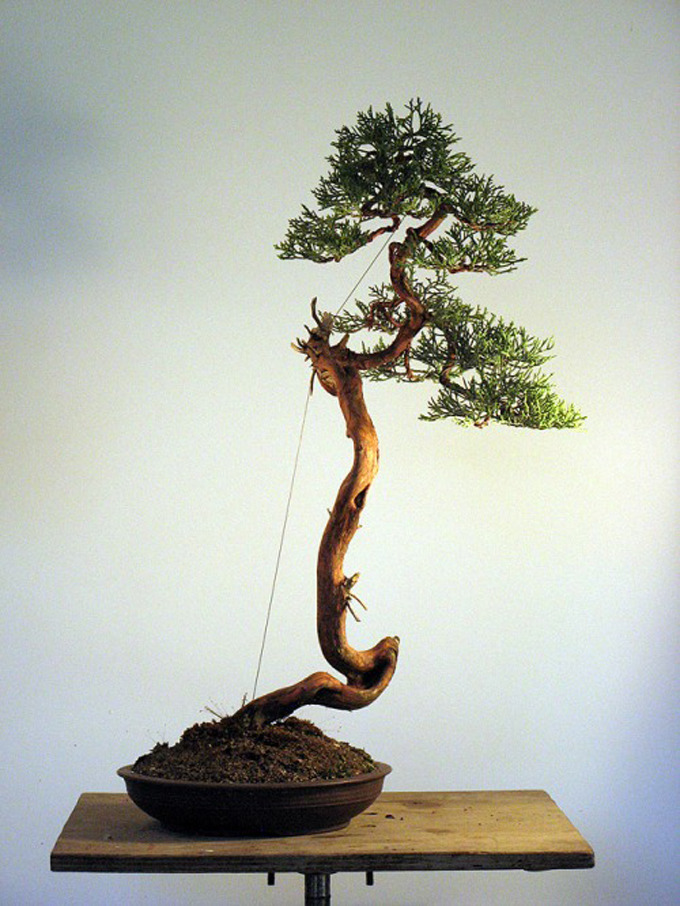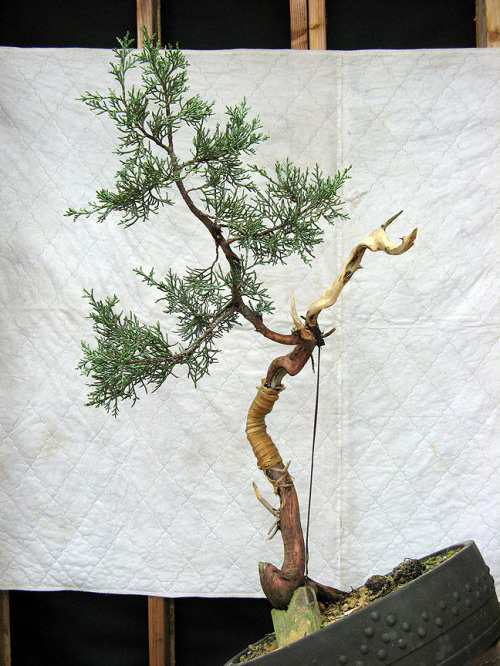 I borrowed this unusual Bunjin style Sierra juniper from Michael Hagedorn’s Crataegus Bonsai. The article is titled Developing an Unpromising Sierra Juniper Bunjin – student work from Seasonal.
I borrowed this unusual Bunjin style Sierra juniper from Michael Hagedorn’s Crataegus Bonsai. The article is titled Developing an Unpromising Sierra Juniper Bunjin – student work from Seasonal.
There’s something about threes
It often works to divide things into thirds to better understand them and for discussion sake. In this tree’s case, you might be struck by the fact that it has three distinct sections:
1. The base. The lowest part starts with a radical slant then takes an abrupt twist. This sudden change of direction is both fluid and abrupt and tells much of the tree’s story. It’s a story that lends drama and mystery that just might peak our interest.
When you’re lucky, you find material to work with that has something this unusual (unusual and often dramatic features are most commonly found in collected trees where nature has had a chance to wreck its havoc). Conversely, features like this that are so eccentric often tend to set up tension that is difficult to reconcile with the rest of the tree. I think the ability to work with these difficult features is one thing that distinguishes bonsai artists from the rest of us hackers.
2. Mid section. The long vertical mid section almost ruined this tree. Originally it was ‘straight as an arrow’ (Michael’s words) but the students were able to put just enough movement in it to save the tree from a life of mediocrity. That’s a good thing; it’s a tree worth saving.
3. The top. Though a bit ‘loose and rangy’ (Michael’s words again), the top section has two excellent features. First, another abrupt turn that lends character and interest (another story perhaps) and then a stretch of classical bunjin elegance, with fluid movement and the typical falling branch. This section works so well in expressing bunjin, that if you cut the trunk off just a little above the abrupt turn at the base, you’d still have a very sweet tree. A little more conventional perhaps, but still….
All together now
The big question is: do these three parts come together in a way that makes sense? When you look at each section by itself, you have to wonder. But when you step back and view the whole tree, Viola!
A very pertinent observation by Michael
“Tricky to get the lighting right in a photo that will express the back and forth movement of the simple trunk. I’ve never been satisfied with images of bunjin, which require the viewer’s presence for a sense of scale, subtleties of movement, and evocativeness.”
Agreed
It’s difficult to capture the third dimension in a two dimensional medium. Many bonsai you see in photos would simply blow you away if you saw them in all their ‘real space’ glory. You could even say that what is lost in most photos, is every bit as much as what is captured.
 At an earlier point. Just after the bend in the mid section is made. This view shows a lot more mid-trunk movement than the view above. In fact, it shows the tree in a whole different light. Another possible front?
At an earlier point. Just after the bend in the mid section is made. This view shows a lot more mid-trunk movement than the view above. In fact, it shows the tree in a whole different light. Another possible front?
Post-Dated – The Schooling of an Irreverent Bonsai Monk by Michael Hagedorn is a great bonsai read. Unique, funny, informative, and very well written. It’s on sale at Stone Lantern.